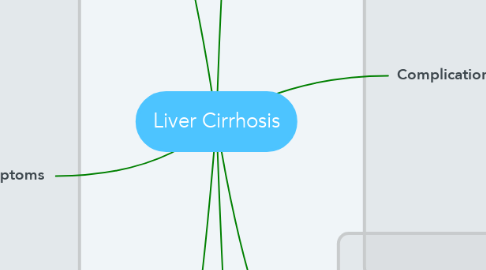
1. Symptoms
1.1. Fatigue
1.2. Fluid accumulation
1.2.1. Ascites
1.3. Edema
1.3.1. Legs, feet and ankles
1.4. Itchy skin
1.5. Vomiting or nausea
1.6. Nutritional problems
1.6.1. Weight loss & loss of appetite
1.7. Redness to palms of hands
1.8. Jaundice
1.8.1. Yellow eyes & skin
1.9. Confusion, drowsiness or slurred speech
1.9.1. Hepatic encephalopathy
1.10. Easy bleeding & bruising
1.11. Females
1.11.1. Absense of menstruation
1.12. Males
1.12.1. Testicular atrophy
1.12.2. Gynecomastia
1.12.3. Loss of sex drive
1.13. Spider-like blood vessels on skin
2. Causes
2.1. Chronic alcohol abuse
2.1.1. Causes - Cell inflammation
2.2. Fat accumulation
2.2.1. Non-alcoholic fatty liver disease
2.3. Autoimmune or infectious hepatitis
2.3.1. Hepatitis B, C or D
2.3.2. Caused by body's immune system
2.4. Excessive drugs
2.4.1. Liver tissue damage by chemicals & minerals
2.5. Bile flow obstruction
2.5.1. Leads to accumulation of cholesterol & tryglycerides
2.5.2. Causes - Problems to blood flow to liver
2.6. Excessive iron levels
2.6.1. Hemachromatosis
3. Disturbances to Liver Functions
3.1. Bile production
3.1.1. Aids - Food digestion
3.2. Blood clotting factors
3.3. Iron processing & storage
3.3.1. Aids - Red blood cell production
3.4. Cholesterol manufacturing
3.4.1. Aids - Fat transport
3.5. Production of amino acids
3.5.1. Aids - Protein production
3.6. Conversion of waste products to urea
3.6.1. Aids - Excretion of urea via xxxx
3.7. Conversion of extra glucose to stored glycogen
3.7.1. Glycogen stored in liver cells to be converted to glucose as required
4. Prevention of further liver damage
4.1. Maintain adequate water intake
4.2. Avoid alcohol
4.3. Low sodium diet
4.4. Healthy diet
4.4.1. Low sugar, high plant based foods, high protein foods
4.5. Vaccinations
4.5.1. Influenza, pneumonia, hepatitis A & B
4.6. Avoid asprin, acetaminophen & iboprofen
5. Treatment
5.1. Reduce alcohol intake to zero
5.2. Reduce salt in diet
5.3. Rest
5.4. Diuretics
5.4.1. Increases salt & water expulsion via urine
5.5. Weight loss
5.5.1. Control blood sugar levels (BSL)
5.6. Medications
5.6.1. To control hepatitis B or C
5.7. Nutritional Supplements
5.7.1. Counteract malnutrition and prevents osteoporosis
5.8. Dietary changes
5.8.1. High protein intake
5.9. Liver transplant
5.9.1. Advanced cases of cirrhosis
6. Diagnosis
6.1. Physical examination
6.2. Ultrasound
6.3. CT scan
6.4. Urine Sample
6.5. Blood tests
7. Complications
7.1. Jaundice
7.1.1. Elevated bilirubin concentration in the blood stream
7.2. Portal Hypertension
7.2.1. Hepatic portal system increase pressure from spleen & intestine to liver
7.2.1.1. Spleen enlargement
7.2.1.1.1. Traps platelets and white blood cells
7.3. Esophageal varices
7.3.1. Abnormal, enlarged veins in esophagus
7.3.1.1. Can lead to excessive bleeding when smaller veins burst due to increased pressure
7.4. Ascites
7.4.1. Abnormal fluid buildup in abdomen
7.4.1.1. Inability to produce blood proteins such as albumin
7.5. Edema
7.5.1. Abnormal fluid build up in legs
7.6. Hepatic encephalopathy
7.6.1. Neuropsychiatric abnormalities such as personality changes, intellectual impairment or depressed level of conciousness
